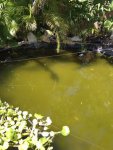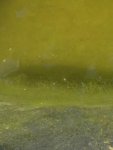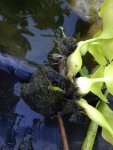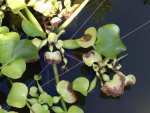Hi All,
I finally got my water testing kit! Yes!
Here are my results:
1) PH 9
2) Ammonia - 0
Nitrite - 0
Phosphate - 0
2) Still green water and it seems to be getting worse. I can barely see my fish - but I guess that means the heron can't see them either. There is lots of algae growing on the sides of the pond liner.
Any thoughts? 3) The UV light is still off. I'm going to continue adding plants. I hate the green water ..... I know, I know, but I hate it. 4) I want a nice clear pond.
5) Question - I've heard the word cycle being used a lot, does that mean that after a few weeks, my pond could, on its on own, cycle into a clear phase?
Thanks,
1) PH 9
Was that pH taken at late afternoon or near dusk?
This may help explain the high pH, but, more than likely, since you mentioned you're on a limestone island, your water just has a very high KH with little calcium in it. Test the pH again in the morning to be sure. If the morning pH test is still 9, then this means you have a good, solid, high level of alkalinity (as expressed by the KH test kit). With these liquid reactant tests, there is around a +/-
.2 variance in accuracy; so, if your API liquid pH test kit says 9.0, then quite likely it is around 8.8~9.2. This is quite high, that is at the limit, and there is likely just an average to low concentration of calcium in the water, which is not really a problem in our context.
If your pH is 8.8~9.2, then the oyster shells and any other aragonite or calcium carbonate product will not help you unless the pH drops around
.4~
.6 points. These products stop dissolving in water with a pH above around 8.3~8.5. This is why my first question is important. If the pH turns out to be much lower in the morning, then the aforementioned product can still help.
I think it would be wise to obtain a KH test kit as well, made by API that was referenced above.
2) Ammonia - 0
2) Still green water and it seems to be getting worse. I can barely see my fish - but I guess that means the heron can't see them either. There is lots of algae growing on the sides of the pond liner.
Any thoughts?
Your green water and algae growing on the side is consuming the ammonia. This is why your ammonia test is 0.
Keep an eye on the algae growing on the side. If it becomes very thick long strands, then this is not good. A basic plastic brush toilet bowl scrubber can fix this by twirling the algae around, like spaghetti, to remove the thick long strands. Be sure it uses somewhat stiff, yet flexible, plastic brushes since you do not want to puncture your pond liner. Pull the algae off the brush and discard it and repeat the process. This type of algae is the most invasive type of weed in a pond and it has a quite strong tensile strength to the point you can almost make a rope out of it.
You are correct in that the thick green water will help with the heron problem.
3) The UV light is still off. I'm going to continue adding plants. I hate the green water ..... I know, I know, but I hate it.
If you turn on the UV light, then this will allow more Ammonia to be available for the algae on the side walls to grow even more. So, this is something to think about if you decide to turn on the UV.
The plants might just need time to adapt to the water conditions. As I mentioned earlier, for me, it took almost a month for the plants to adapt.
4) I want a nice clear pond.
Yep, most do.

Due to the type of filtration you are using, this is just the struggles that the pond will be experiencing. Since you want to do a bog, if you can get your bog project done, then this will help.
Slow,
steady, major water changes will help, but stop doing the major water changes once it clears up. To do a
slow,
steady, major water change, then first remove 40% of the pond's water. Then, add new water at only a very slow flow, or near a tickle, into the pond, so that it takes about 12 hours or so to fill up the pond. If you have chlorine or chloramine in the water, then periodically dose the water is this is being doing, but, since you're on well water, then you likely do
not need a dechlorinator. This water change is done slowly so to avoid shocking your fish's immune system. If the water change was done fast, then quite likely the pH change and/or water temperature will put the fish into a shock.
5) Question - I've heard the word cycle being used a lot, does that mean that after a few weeks, my pond could, on its on own, cycle into a clear phase?
"Cycle" or "Cycling" refers to the nitrification process. Nitrification process is the natural process referencing how Nature cleans the water and converts the ammonia pollution into plant soluble nutrients.
In your situation, this is called NPS (new pond syndrome). A pond has completed its cycle, NPS, once there is
zero Ammonia and
zero Nitrite and
Nitrates are showing up on the test.
Honestly, ponds never stop "cycling". This is a vital part of Mother Nature's ecosystem since ammonia is always constantly produced by fish. However, the cycling is not, or should not be, as bad as you are experiencing in your pond once the pond matures, that is as the plants become older and microorganisms are established and older.








